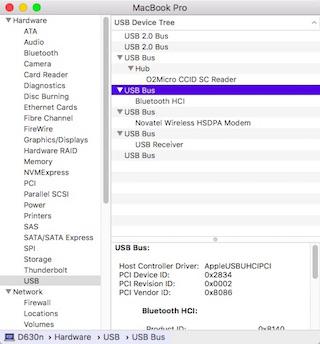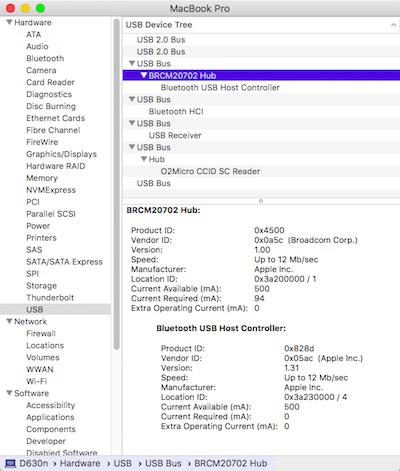-
Posts
10067 -
Joined
-
Last visited
-
Days Won
569
Content Type
Profiles
Articles, News and Tips
Forums
Everything posted by Hervé
-
Boot in verbose mode to se when it hangs.
-
No, do not attempt to upgrade to anything past Lion. OS X last supports the D620 GPUs (whether Intel GMA950 or nVidia Quadro NVS 110M) in Lion 10.7.5 and in 32bit kernel mode. Beyond Lion, you'll have no graphics support/acceleration so do not bother. Pleased read the thread I linked to previously. To get fully functional Sleep/Wake operations, you'll need to: 1) set hibernate mode to 0 2) remove any sleepimage file in /var/vm I also recommend you align screen sleep on computer sleep in the Energy Savings PrefPane. Reason for that is that if you let the screen sleep on the D620 nVidia, it only wakes to a dark screen and you'll have to put the laptop to sleep, then wake it to recover display.
-
Try the following: Delete myHack.kext from /S/L/E Delete your /Extra folder Run myHack ans install your Extra again (pointing to the downloaded pack that you'll keep in, say, the Download folder).
-
It's a well know fact that every update installs a vanilla AppleHDA which therefore requires re-patching. The alternative is indeed to replace the new vanilla kext by an earlier pre-patched Sierra version.
-

X62 (i7-5600u, HD5500) - El Capitan install issues?
Hervé replied to flyingfishfinger's topic in The Archive
You can manually update the database file as specified on Pike R Alpha's repo. -
You update through combo update or via Apple menu. As simple as that.
-
There's no need for the nv_disable=1 parameter, that laptop has no nVidia GPU. The AMD GPU is not supported so it won't affect the system in any way. You've got the Intel GPU injection correct but you've not mentioned the Azul Framebuffer. The E6x40 laptops with HD4600 graphics require you to inject Azul FB #12, i.e. layout-id 0x0a260006. With your HiRes LCD, you may also need to set DualLink to 1.
-
It normally works with the PS2 kexts provided in the pack. Make sure you've run myFix after applying the pack.
-
Are you using myHack with the posted pack? Try and specify -f -v flags at Chameleon prompt.
-
1st make sure to use the latest D620 BIOS version A10 and a Core2Duo CPU (most D620 have a FSB667 Merom T7x00 CPU). Then configure the BIOS parameters as per the recommended settings posted here. To build your Lion USB installer, use myHack v3.1.2 or v3.3.1 + the Lion bootpack available here. This will get you to a known working installation.
-

Help with El Capitan, Clover changing SIP setting in config.plist
Hervé replied to jfmac's topic in The Archive
You would not need to re-install the OS from scratch... Just the bootloader. -

Help with El Capitan, Clover changing SIP setting in config.plist
Hervé replied to jfmac's topic in The Archive
You gotta love Chameleon! -

DW1550: trouble getting Bluetooth to work in my D630
Hervé replied to hackie1056's topic in The Archive
Erm... your SysProfiler output is from Mavericks... Not really what I was looking for. There is no sign of your DW1550 built-in BT module in your SysProfiler so it's clearly not registering as a USB device. I also note that you don't appear to use the latest optimised Mavericks' pack available here. Can you please post the saved SysProfiler output taken from El Capitan or Sierra with the DW1550 installed and the CSR dongle taken off? Whilst you're at it, also post: 1) your complete zipped /Extra folder (you're using Enoch, right?) without the Themes subfolder to minimise size 2) a saved IOReg output from IORegistryExplorer (both from El Capitan or Sierra) If you have an internal Bluetooth module such as a DW350 or DW360, disable the Internal Bluetooth in BIOS; otherwise, it'll take precedence... Your USB ports & devices should look like this under Sierra: As a test, I installed a spare Apple BCM94360CD (Combo Wifi 802.11ac + BT 4.0 card) in the WWAN slot of my D630. As expected, the Bluetooth module of the card is properly detected and listed as an internal USB device: -

Help with El Capitan, Clover changing SIP setting in config.plist
Hervé replied to jfmac's topic in The Archive
Yes, you can run El Capitan and/or Sierra with CsrActiveConfig set to 3. That's what I use on all my Hacks, E6230 included. Reboot without cache when you 1st call on the revised value and rebuild your cache thereafter. -

DW1550: trouble getting Bluetooth to work in my D630
Hervé replied to hackie1056's topic in The Archive
Can you explain the details of what you did regarding Rehabman's kexts? The process works perfectly for a DW380 (Broadcom BCM20702 chipset) so I don't see why it would be different on a DW1550 which is clearly mentioned in Rehabman's list of tested & supported devices. Please post a zipped SysProfiler saved output. -
I don't follow what you do at all, but you're obviously not doing this right. You need to follow the guide step by step and you'll get there, unless you have a duff USB key of course...
-

[CLOVER] Dell Inspiron 3542 (Automatically restarts on install)
Hervé replied to ck3k's topic in The Archive
The reboot is probably due to the unsupported CPU model. I guess you'd have to try and fake a different CPU id. I don't think this specific Haswell Intel HD graphics GPU is supported either... In other words, don't hold your breath; you may have to upgrade your CPU to a supported Core "i" model to be able to install and run OS X. -

Kernel panic after NVDAStartup: Official on E6500 with NVS 160m?
Hervé replied to swimllamaswim's topic in The Archive
The Intel GMA4500 GPU fitted to the E6x00 family is unsupported, so you can forget about hackintoshing them indeed. For the E6500 with nVidia GPU, make sure to use MacBookPro7,1 profile. You can look at my D630 nVidia Sierra guide for pointers. You may reuse many items from the pack I posted (obviously DSDT + some kexts will need to be replaced). Look up existing E6x00 nVidia pack to retrieve the hardware specific kexts (like LAN driver for instance). -
The latest OS X version you can run on a D620 with GMA950 is Lion 10.7.5. From Mountain Lion 10.8, Apple dropped support for the obsolete Intel GMA GPU. For Lion, we advocate you build a USB installer using myHack utility. If you have no access to a Mac or an existing Hack, try using a virtual machine. You can use the Lion bootpack available here. Please note that the D620 is fitted with Intel ICH7-M I/O controlller so disk mode is limited to IDE, not AHCI and SATA-II (3Gb/s) speed. Your SSD will therefore only appear like a traditional HDD and you'll have no support for Trim. Still, it'll run faster than a good old HDD.
-
Re-nable IDA.
-
There is a dedicated section about multi-OS booting. https://osxlatitude.com/index.php?/forum/172-multiple-boot/
-
If you want an easy Sierra installation on your E6220, I invite you to follow this guide.
-

Dell Latitude 3570 (Core i5 6200U): help installing macOS Capitan 10.11.6
Hervé replied to phinq1910's topic in The Archive
Keyboard backlight is controlled through BIOS settings, not Operating System. -
https://github.com/Piker-Alpha/ssdtPRGen.sh Read then follow the instructions.
-

E6230, i5-3340, Sierra 10.12.1, Wifi and Trackpad Problem
Hervé replied to Karl V.'s topic in The Archive
Try to put the laptop to sleep then wake it. Headphones should then work. Remember to re-patch your AppleHDA binary file if you update Sierra, though reverting to v278.52 of my posted pack should work too. The patch is as follows: Find: 8419B411 Replace by: 00000000 Find: 8A19D411 Replace by: 00000000 Find: 8B19D411 Replace by: DF761D11 There are 2 x instances each time. I've not needed CodecCommander or EPADFix but you may add it if you find that the headphone output does not always work until your put laptop to sleep then wake it.





